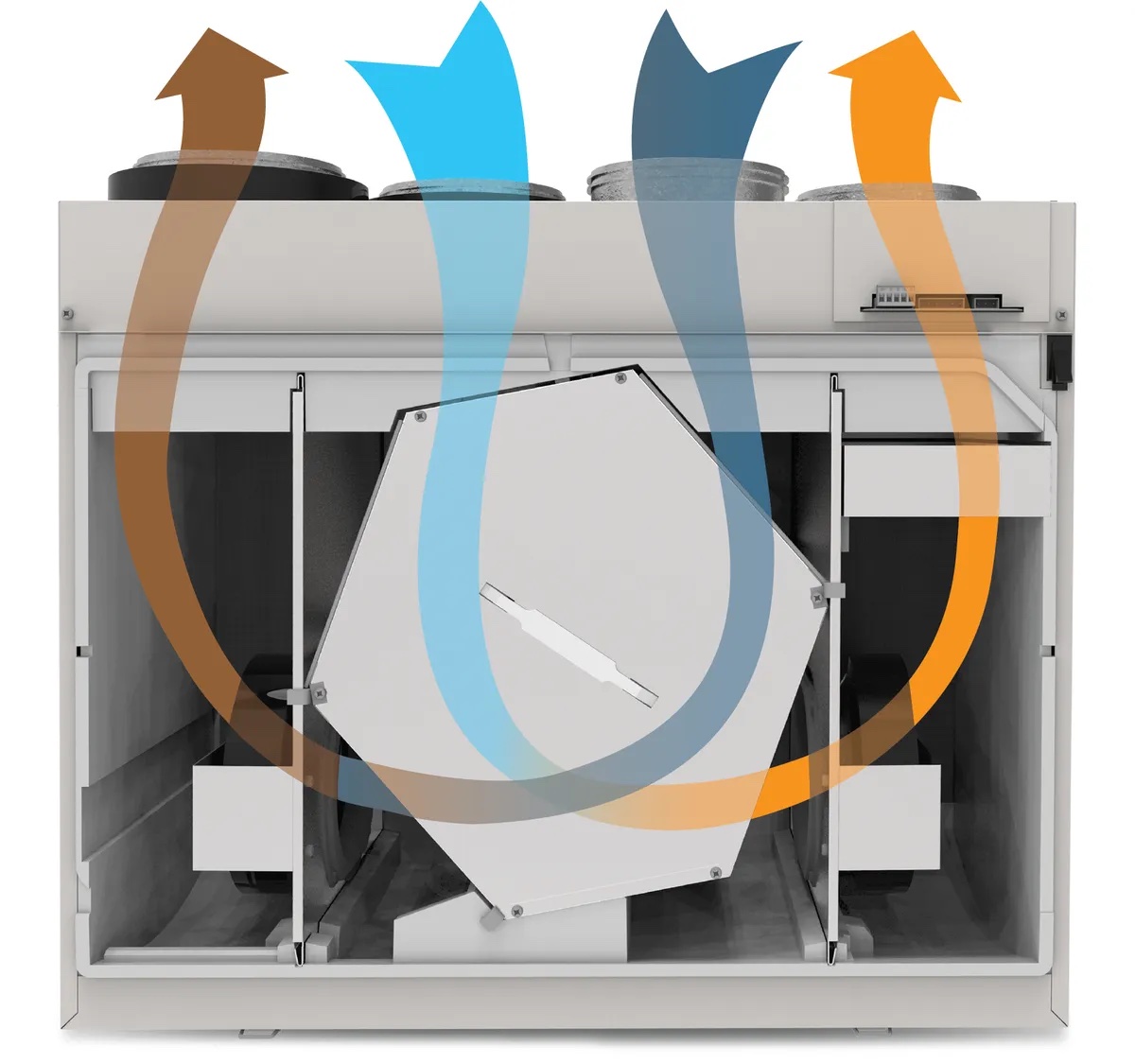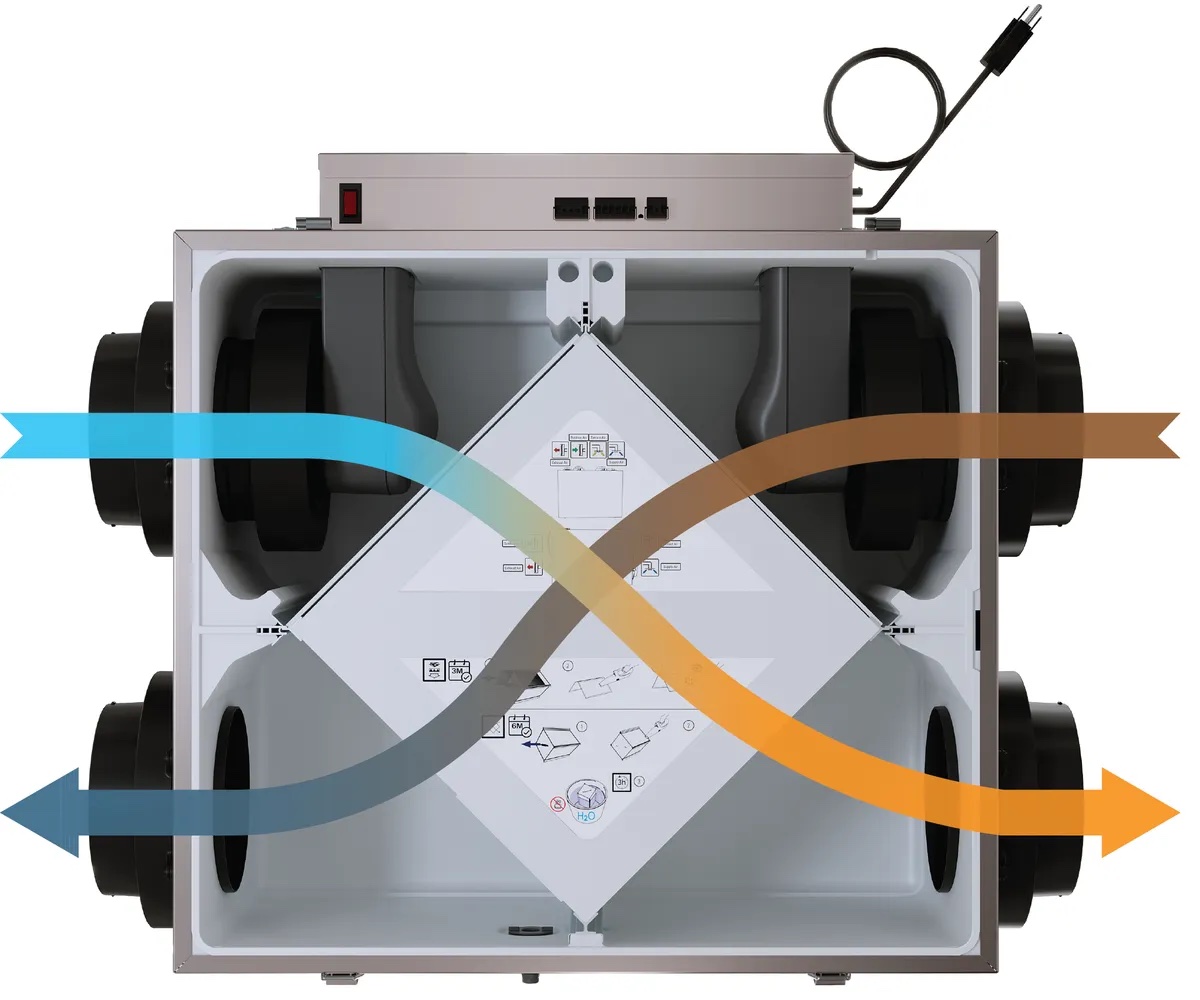Balanced ventilation is a critical concept in modern building design, referring to ensuring equal amounts of incoming and outgoing air in a home.
Balanced ventilation systems mitigate the common issues associated with exhaust-only or supply-only systems, such as pressure imbalances and uneven temperature distribution. By ensuring a balanced approach, these systems help maintain a healthier and more comfortable indoor environment.
Fresh Air Appliances with heat (HRV) or energy recovery (ERV) are types of balanced ventilation systems that provide controlled and equal airflow, enhancing indoor air quality and energy efficiency.
A Technical Examination into Humidity, Location, and Optimal Choices
When building new or renovating existing homes, selecting between a Fresh Air Appliance with heat recovery and one with energy recovery is a critical decision that impacts indoor air quality and energy efficiency.
This article gets into the Fresh Air Appliance with heat recovery versus the Fresh Air Appliance with energy recovery debate, emphasizing the importance of humidity control, geographic location, and the nuanced considerations that leads to the optimal choice for your project.
Travis Brungardt, a building professional and co-host of BS** and Beer Show (**Building Science), highlights the significance of balanced ventilation:
"Balanced ventilation is key to achieving optimal indoor air quality and energy efficiency. Whether using a Fresh Air Appliance with heat or one with energy recovery, ensuring that the system provides equal air exchange is crucial for maintaining a healthy and comfortable living space."
Technical Overview of Fresh Air Appliance with heat (HRV) or energy recovery (ERV)

Fresh Air Appliance with Heat Recovery (HRV)
Fresh Air Appliances with heat recovery are engineered to facilitate air exchange between the interior and exterior environments while retaining heat.
During winter, the heat from outgoing warm air is transferred to incoming cold air, reducing the heating load. Conversely, in summer, the system operates to reduce the temperature of the incoming outdoor air by allowing it to transfer its heat to the air being exhausted from inside the home.
This thermal exchange mechanism ensures efficient energy utilization and consistent indoor temperature maintenance.

Fresh Air Appliance with Energy Recovery (ERV)
Fresh Air Appliances with energy recovery function similarly to Fresh Air Appliances with heat recovery in terms of air exchange but incorporate the additional capability of transferring moisture.
This dual exchange of heat and humidity is pivotal in regulating indoor moisture levels, making Fresh Air Appliances with energy recovery particularly advantageous in climates with significant humidity variations.

It’s important to understand that the efficient transfer of energy occurs in HRV and ERV appliances through a layered core that allows for energy transfer without any air leakage or mixing. The exhaust air carrying the ideal indoor temperature passes through the core simultaneously with the incoming air so the energy (heat) transfer can occur to temper that air accordingly.
With a clear understanding of how Fresh Air Appliances with heat or energy recovery function, it's essential to consider the nuances—such as humidity control and geographic location—that determine the optimal choice for your specific project.

Humidity Control: A Determinant Factor
Humidity management is a principal consideration in the Fresh Air Appliance with heat vs. energy recovery decisions. In arid climates, Fresh Air Appliance with heat recovery (HRV) may suffice since humidity regulation is not a primary concern. However, in humid climates, Fresh Air Appliances with energy recovery (ERV) is instrumental in managing moisture levels from the outgoing air into the incoming air, thereby mitigating risks associated with mold, mildew, and overall indoor air quality.
Travis Brungardt underscores the importance of humidity control:
"In regions with high humidity, a Fresh Air Appliance with energy recovery is often indispensable. It not only helps to maintain comfortable humidity levels but can also address moisture-related issues, which are critical for ensuring a healthy indoor environment."
Geographic Location, Climatic Implications
Geographic locations significantly influence the choice between a Fresh Air Appliance with heat recovery and one with energy recovery. Here is a detailed guide:

Practical Considerations for Builders and Contractors
For professionals in the construction industry, the choice between Fresh Air Appliance with heat or one with energy recovery has practical implications for design and implementation. Key considerations include:
Installation Requirements
Typically, a Fresh Air Appliance connects to the existing HVAC system with dedicated supply and return ducts and are either top or side-ported.
Energy Efficiency
Both systems enhance energy efficiency, but local climate conditions will determine which system maximizes energy savings.
Cost Analysis
Initial costs for a Fresh Air Appliance differ, with energy recovery appliances generally incurring higher upfront expenses due to their enhanced functionality. However, long-term operational efficiencies coupled with enhanced indoor air quality often justify the investment.
Optimal Solutions for the Homeowners
As builders and contractors, it is essential to guide homeowners on the benefits of Fresh Air Appliances with heat recovery and Fresh Air Appliances with energy recovery to ensure their satisfaction:

The decision between a Fresh Air Appliance with heat recovery and one with energy recovery hinges on specific climatic conditions and user requirements. For builders and contractors, understanding the technical advantages of each system allows for better recommendations, ultimately enhancing client satisfaction through improved comfort and energy efficiency."

Travis Brungardt
Building professional and co-host of BS and Beer KC
Final Thoughts and Recommendations
Selecting between a Fresh Air Appliance with heat or one with energy recovery is a critical aspect of creating a comfortable and energy-efficient home. By meticulously considering factors such as humidity, geographic location, and specific project needs, builders, contractors, and homeowners can make well-informed decisions that optimize indoor environmental quality.
The ideal choice varies according to individual circumstances, but with a deep understanding of these systems, one can confidently determine the best solution for their specific climatic and lifestyle requirements.
Read original blog